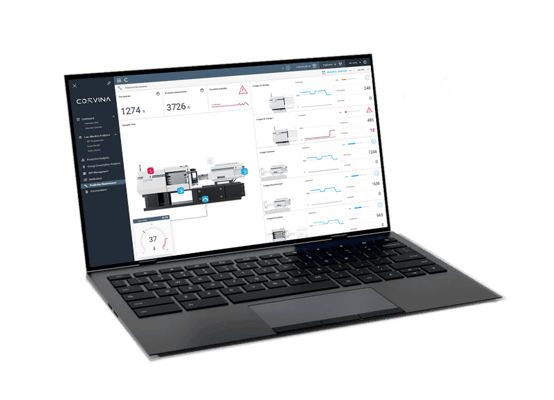Industrial IoT Applications
Discover the limitless possibilities of our CORVINA effective industrial IoT applications. Immerse yourself in a world where connectivity and automation converge to revolutionize the way industries operate. Explore how our cutting-edge CORVINA technology combines the power of the Internet of Things with industrial efficiency, paving the way for enhanced productivity, streamlined processes, lean production system and cost-effective solutions.
Stay on top of your data with this powerful cloud alarm application. Effortlessly create, manage, and monitor alarms, and receive instant notifications via Email, Telegram, Webhook, or Microsoft Teams to keep your team informed and responsive.
Empowers businesses to effortlessly manage edge device fleet, with remote provisioning, monitoring, and secure updates, including BSPs and applications at scale, ensuring efficiency, reliability, and enterprise-grade security. Read more >
Extend edge device fleet management across your organization and to your customers, enabling seamless remote provisioning, monitoring, and secure updates at scale, with efficiency, reliability, and enterprise-grade security. Read more >
A complete set of widgets and tools designed to simplify energy management from real-time monitoring to detailed consumption analysis across periods and organizational structures.
Unlock the full potential of your production plant with this industrial machine modeling app by Factoryal, a company inside X Platform services. Seamlessly manage the XLayer platform and automatically deploy machine communication modules, accelerating connectivity, boosting efficiency, and simplifying plant operations.
Easily manage your repositories with a seamless way to store, share, and access artifacts. Upload and download items by name and version tag, ensuring fast, reliable, and organized artifact management. Read more >
Effortlessly extract insights from your dashboards and keep your team in the loop with automated report generation and email notifications. Stay informed, act faster, and make data-driven decisions with ease.
Protect your industrial devices with a powerful, easy-to-use app that detects vulnerabilities, anticipates risks, and safeguards your data. Stay secure and up to date with the latest cybersecurity guidance, ensuring business continuity and peace of mind.
Custom Apps
Your processes are unique, your apps should be too. Corvina lets you build and deploy custom Industrial IoT applications that adapt to your machines, workflows, and business goals.
With no-code tools and open APIs, you can go from idea to industrial-grade app quickly, securely, and at scale.

What are the criteria for choosing your supplier
Concern - The platform should be able to scale to accommodate changes in the size of the business or the number of machines being monitored. This means it should be able to handle increasing amounts of data, support additional users, and integrate with new systems as the business grows.
Response - CORVINA's platform is built to scale with your business, whether you need to monitor a few machines or thousands. Our platform is designed to handle increasing amounts of data and users, so you can keep growing without worrying about outgrowing your monitoring system.
Concern - The platform should be customizable to meet the unique needs of the business. This includes the ability to create custom dashboards and reports, set up alerts and notifications, and configure analytics to match the specific metrics and KPIs that the business cares about.
Response - With CORVINA's platform, you can create custom dashboards, alerts, and reports to meet your unique needs. Our system is designed to be flexible and customizable, so you can monitor the metrics that matter most to your business.
Concern - The platform should have robust security features to protect sensitive data and ensure compliance with industry standards. This includes features like secure data storage, encrypted data transmission, role-based access controls, and compliance with industry standards like GDPR or HIPAA.
Response - CORVINA takes data security seriously, and we have implemented robust security features to protect your sensitive data. Our platform uses encrypted data transmission, role-based access controls, and secure data storage to ensure your data is always safe and secure.
Concern - The platform should provide real-time monitoring and analytics to detect potential issues before they cause downtime or damage. This means providing continuous monitoring of machine performance, as well as real-time alerts and notifications when problems are detected.
Response - Our platform provides real-time monitoring and analytics, so you can detect potential issues before they cause downtime or damage. Our system is designed to provide continuous monitoring of machine performance, as well as real-time alerts and notifications when problems are detected.
Concern - The platform should provide predictive maintenance features to enable proactive maintenance, reduce downtime, and improve equipment lifespan. This includes features like predictive analytics, machine learning algorithms, and AI-powered anomaly detection to identify potential problems before they occur.
Response - With CORVINA's platform, you can leverage advanced predictive maintenance features to proactively maintain your machines and prevent downtime. Our system uses predictive analytics, machine learning algorithms, and AI-powered anomaly detection to identify potential problems before they occur.
Concern - The platform should be able to integrate with existing systems, equipment, and software to avoid disruptions and maximize efficiency. This means supporting integration with a wide range of machine types, protocols, and data formats, as well as providing APIs and webhooks for easy integration with third-party software.
Response - CORVINA's platform is designed to integrate seamlessly with your existing systems, equipment, and software. We support a wide range of machine types, protocols, and data formats, and provide APIs and webhooks for easy integration with third-party software.
Concern - The platform should be easy to use and navigate, with a user-friendly interface that doesn't require extensive technical knowledge. This means providing intuitive dashboards, drag-and-drop tools for setting up alerts and notifications, and clear documentation and support to help users get up and running quickly.
Response - Our platform is designed to be user-friendly and easy to navigate, even for non-technical users. We provide intuitive dashboards, drag-and-drop tools for setting up alerts and notifications, and clear documentation and support to help users get up and running quickly.